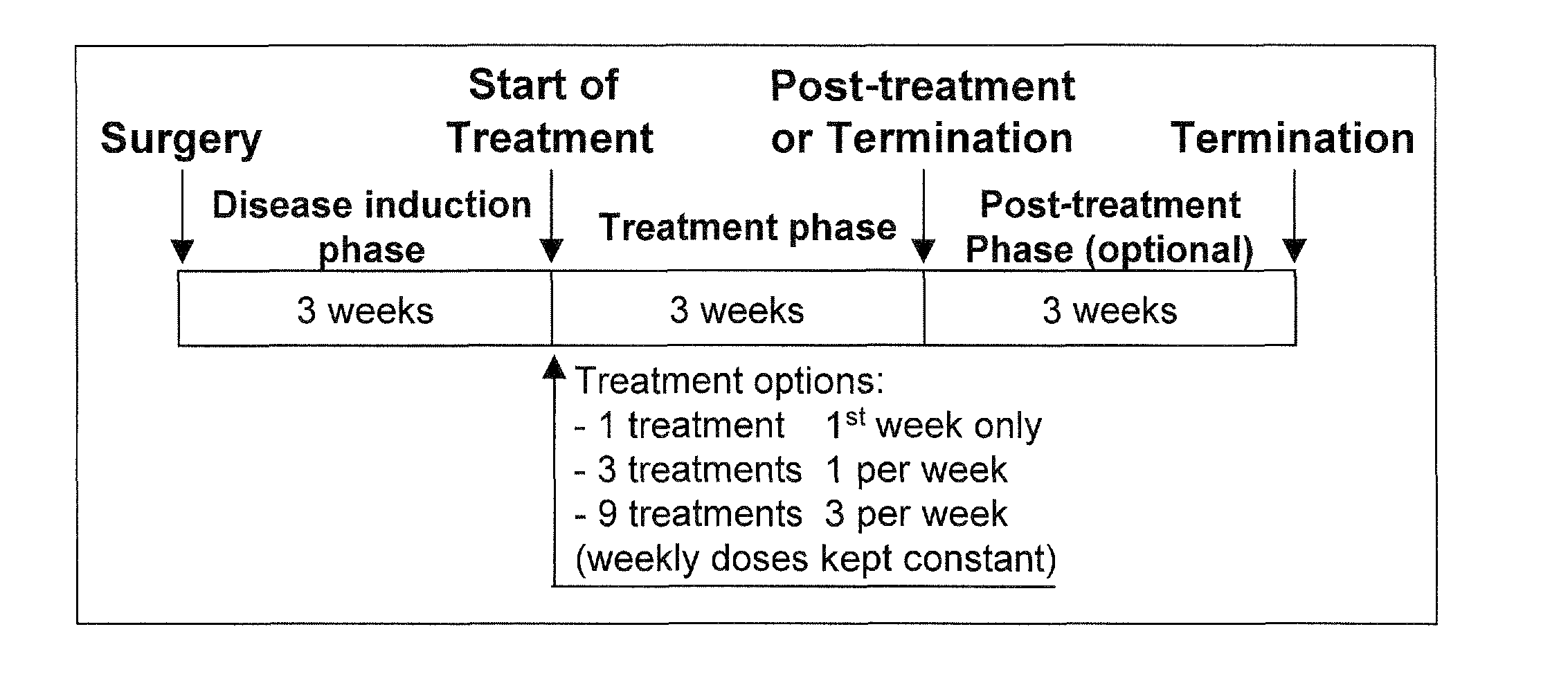Treatment of cartilage disorders with FGF-18
a cartilage disorder and fgf-18 technology, applied in the field of medicine, can solve the problems of unpredictable and effective available treatments, and little or no effect on the regeneration of damaged tissues
- Summary
- Abstract
- Description
- Claims
- Application Information
AI Technical Summary
Benefits of technology
Problems solved by technology
Method used
Image
Examples
example 1
Disease Models in Animals and Extended Pharmacology
[0128]In vivo, FGF-18(170AA) was tested in different disease models of OA and damaged cartilage, with significant therapeutic efficacy using an intra-articular (i.a.) dosing. Overall a therapeutically effective dose of 3-40 μg i.a. per animal / week was demonstrable in different species (rat, dog). Results from the aforementioned animal models of disease (OA as well as cartilage defects) are summarized below.
[0129]
TABLE 1Summary of pharmacology studies with FGF-18(170AA)DiseaseDosageAnimalmodel(μg / injection)Route / AdministrationResultsRatInjury-induced0.1, 1, 5Twice weekly i.a.Reduced cartilage degenerationOA(formulated ininjections for 3 weeksReduced depth of cartilage lesions in a dose-dependenthyaluronan)manner. Statistical significance was achieved in the 5 μggroup.Meniscal tear0.1, 1 or 10Twice weekly i.a.Reduced cartilage lesion scores in the medial tibialmodel of OA (I)(formulated ininjections for 3 weeksplateau (up to 64% decre...
example 1.1
Rat Meniscal Tear Model of OA
Method
[0131]Male Lewis rats (5-10 / group) underwent surgery to induce a medial meniscal tear in the right knee joint. Dosing by the i.a. route was initiated 19-21 days after surgery at doses of 0.3, 1, 3 or 10 μg (formulated in saline) to determine pharmacodynamic effects related to the dosing regimen. These total doses were administered either as (i) single dose, (ii) once weekly (⅓ of total dose per injection) for 3 weeks, or (iii) three times weekly for 3 weeks ( 1 / 9 of total dose per injection)(FIG. 1).
[0132]At the conclusion of treatment or after 3 weeks post-treatment, right knees were collected for histopathology evaluation of potential effects. Evaluation of the lesions was performed in 3 different zones: regional differences across the medial tibial plateau were taken into consideration by dividing each section into 3 zones (1—outside, 2—middle, 3—inside). In the surgical OA model, the outside (z1) and middle (z2) thirds are usually most severely...
example 1.2
Dog Menisectomy Model of OA
[0142]Female beagle dogs (n=3 / group) that had had unilateral partial medial menisectomy on the left knee one month prior to initiation of treatment were treated with saline or 3, 10, or 30 μg FGF-18(170AA) once, once weekly, or three times weekly (divided ⅓ doses) for 3 weeks to determine beneficial effects on established OA.
[0143]After 3 weeks of treatment, left knees were evaluated for effects on gross (n=3 / group) and microscopic (n=3 / group) changes induced by menisectomy and for evidence of anabolic effects. All dogs except one exhibited normal appetite and activity throughout the study. One dog (YLI-8) from group 12 died prior to termination (day 17) due to aspiration pneumonia associated with repeated anesthesia for joint injections. Typical degenerative changes characterized by the presence of focal, well circumscribed lesions of cartilage degeneration were present on the medial tibias of all operated dogs in all groups. Femoral lesions were sporadic...
PUM
| Property | Measurement | Unit |
|---|---|---|
| molecular weight | aaaaa | aaaaa |
| Tm | aaaaa | aaaaa |
| pH | aaaaa | aaaaa |
Abstract
Description
Claims
Application Information
 Login to View More
Login to View More - R&D
- Intellectual Property
- Life Sciences
- Materials
- Tech Scout
- Unparalleled Data Quality
- Higher Quality Content
- 60% Fewer Hallucinations
Browse by: Latest US Patents, China's latest patents, Technical Efficacy Thesaurus, Application Domain, Technology Topic, Popular Technical Reports.
© 2025 PatSnap. All rights reserved.Legal|Privacy policy|Modern Slavery Act Transparency Statement|Sitemap|About US| Contact US: help@patsnap.com

